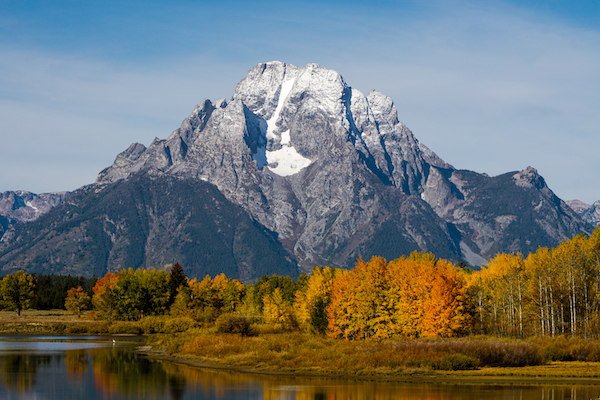Winter Wolves and Wildlife of Yellowstone
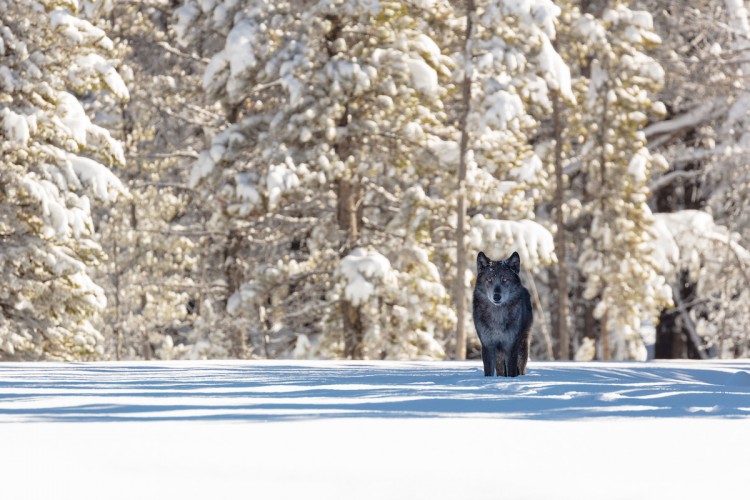

A 6 day exploration of the Winter Wonderland of Yellowstone National Park, it’s wolves and other diverse wildlife species. (wolf photo credit NPS /Jake Frank)
“Wolves by Hellroaring!” We excitedly pull in to a snow-covered pull out overlooking Hellroaring Creek and the Yellowstone River. I set up our Maven S.1 Spotting Scopes on the pack of 16 wolves, who are moving with purpose towards a herd of bison.
Winter is the time of the wolf, and there is no better place in the lower 48 states to look for them than Yellowstone National Park. Each winter we lead guests in search of these apex predators and the multitude of other wildlife species who call the Greater Yellowstone Ecosystem home. This intimate journey takes us through the territories of four known wolf packs in the Northern Range of Yellowstone, including the Lamar Valley, and into the heart of the park’s snowy interior via private Snowcaoch.
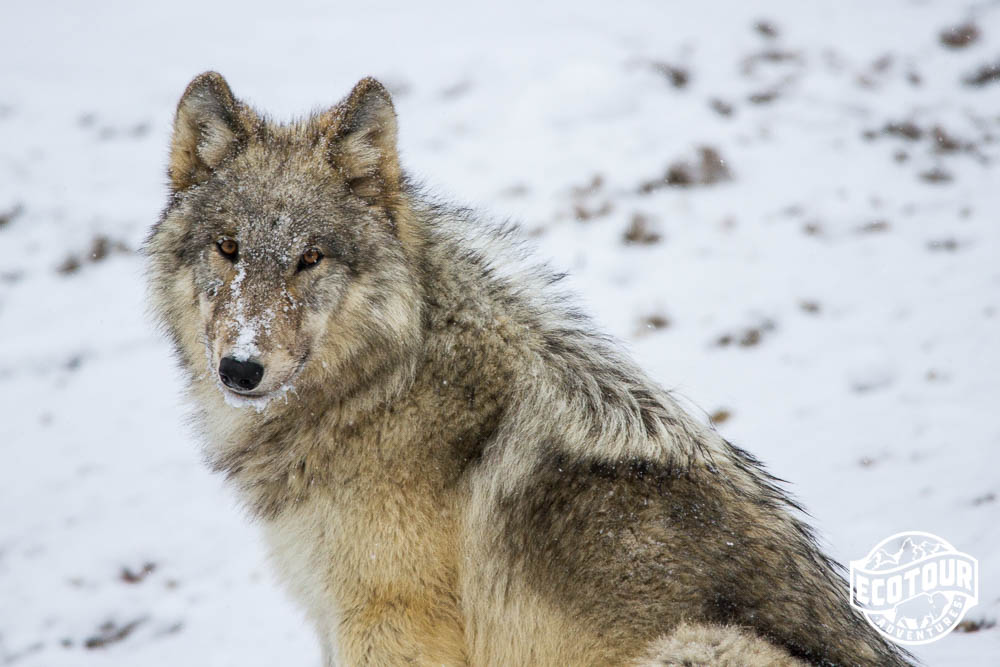
Though close up sightings like this one are possible on tours of Yellowstone, most wolf watching occurs with the aid of spotting scopes and binoculars. Photo by ETA Naturalist
From sparse crowds to concentrated wildlife and stunning winter landscapes there’s a reason why wildlife enthusiasts love winter in Yellowstone, here's why.
Winter Wildlife Watching in the Greater Yellowstone Ecosystem
As winter comes to Yellowstone country, deep snows bury the high country in a blanket of white. Thousands of elk, pronghorn antelope, mule deer and bison retreat out of the parks interior, heading for low elevation winter range. In Northern Yellowstone, low elevation valleys and slopes provide critical habitat for these migrants, and the species who rely upon them.
The morning after our arrival and orientation dinner we load up into our Safari Style EcoTour Adventures 4x4 Van and head towards Yellowstone via the wildlife-filled Paradise Valley. Flanked by towering snowy peaks to the east and west, the Yellowstone River winds its way through this aptly named valley. We stop for views of large herds of white tail and mule deer, scanning for bald eagles perched in the cottonwoods along the water.
In winter, rough-legged hawks migrate here from summer nesting territories over 2500 miles to the north above the arctic circle. Waterfowl, including trumpeter swans and a diverse variety of ducks, have also moved in, taking advantage of the Yellowstone River’s open water for the winter months.
We find a large herd of elk on winter range, some having made the long trek from summer habitat over 60 miles away along the shores of Yellowstone Lake. These migrations underscore the importance of protecting critical habitat outside of the park in order to have wildlife inside it. We follow the migration route towards the park, scanning the cliffs of the canyon for soaring golden eagles and bighorn sheep.
Nearing the Roosevelt Arch, we encounter a large herd of several hundred pronghorn antelope. I point out the lack of large horns in the group, unlike other horned animals pronghorn shed their horns each winter and this group has already done so. The Pronghorn bucks we’re looking at will soon begin regrowing theirs for the following summer.
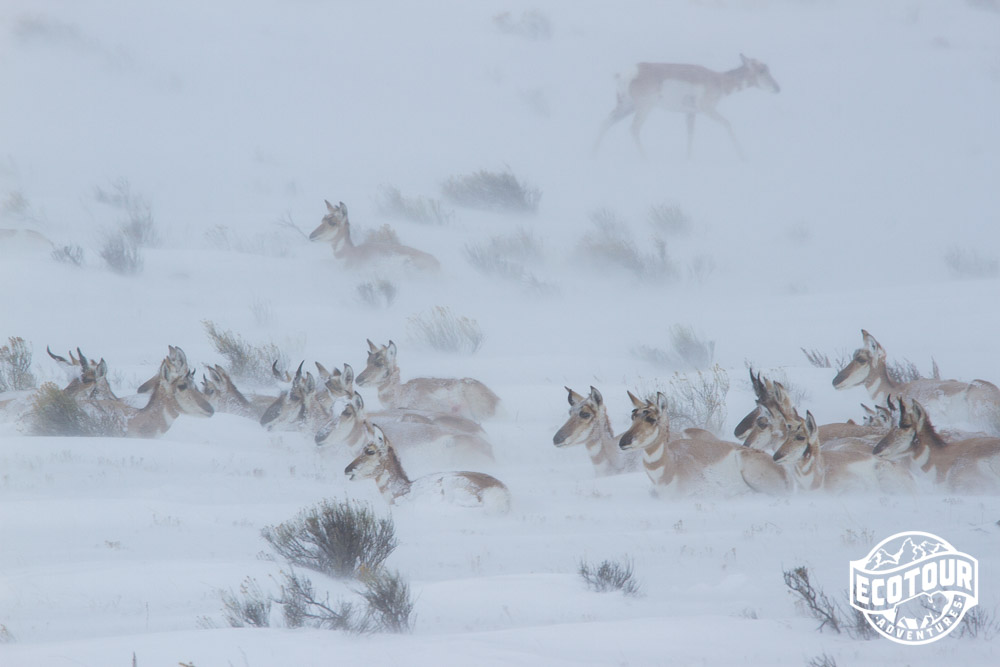
Much of the Yellowstone pronghorn antelope population migrates out of the park in winter, heading down in elevation to avoid deep snows in the park’s interior.
Arriving at the gateway town of Gardiner, MT we take in panoramic views of Yellowstone National Park to the south and the Absorka-Beartooth Wilderness to the North. Towering over the town stands Electric Peak, so named for the explorers who experienced electrical discharges as they retreated down the mountain from an advancing electrical storm. With its proximity to the park and amenities, Gardiner, or nearby Mammoth (also the YNP Headquarters) makes for an ideal location to base our Winter Wolves and Wildlife of Yellowstone tour. We settle in, preparing for the next day.
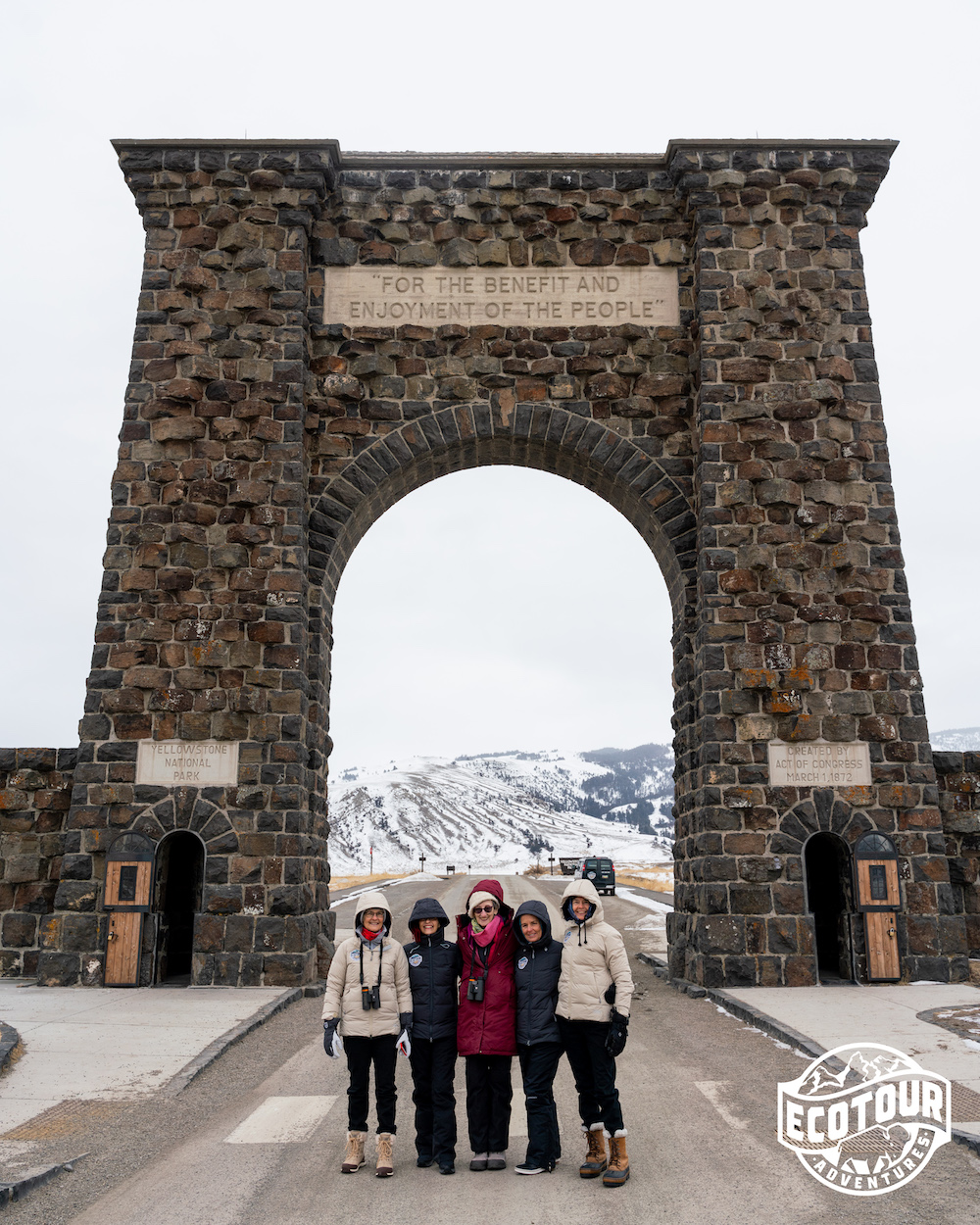
The Roosevelt Arch, constructed in 1903 and named for President Theodore Roosevelt marks the North entrance of Yellowstone National Park
Yellowstone’s Lamar Valley
Wildlife watching in Yellowstone begins with a predawn start and hot french press coffee to start the day. We climb the road out of Gardiner, passing herds of elk and bison and taking a moment to enjoy some antlered mule deer bucks feeding on sagebrush near the Park’s headquarters. The silvery green leaves of this hardy plant have a fragrant odor but the plant is different from its culinary counterpart with the same name. Few animals are able to digest sagebrush but for mule deer in winter it is absolutely critical.
We head east towards the Northern Range, encountering herds of bison taking advantage of the plowed roads including watching a group crossing the high bridge over the Gardiner River. Near Lava Creek, a herd of bachelor bull elk feed, digging through the deep snow to find dried grasses from the previous summer. Their bone antlers will fall off and begin regrowing in early spring; scientists have recently published research suggesting this is an adaptation which allows bulls to use them as weapons to defend against predators. Elk are the primary prey species of wolves and have spent milennia adapting to predation pressure as a result. (VIDEO: Watch as the Wapiti Lake Pack tests two bull elk during a winter Yellowstone tour earlier this year. The wolves soon retreated and the bulls went back to feeding minutes later.)
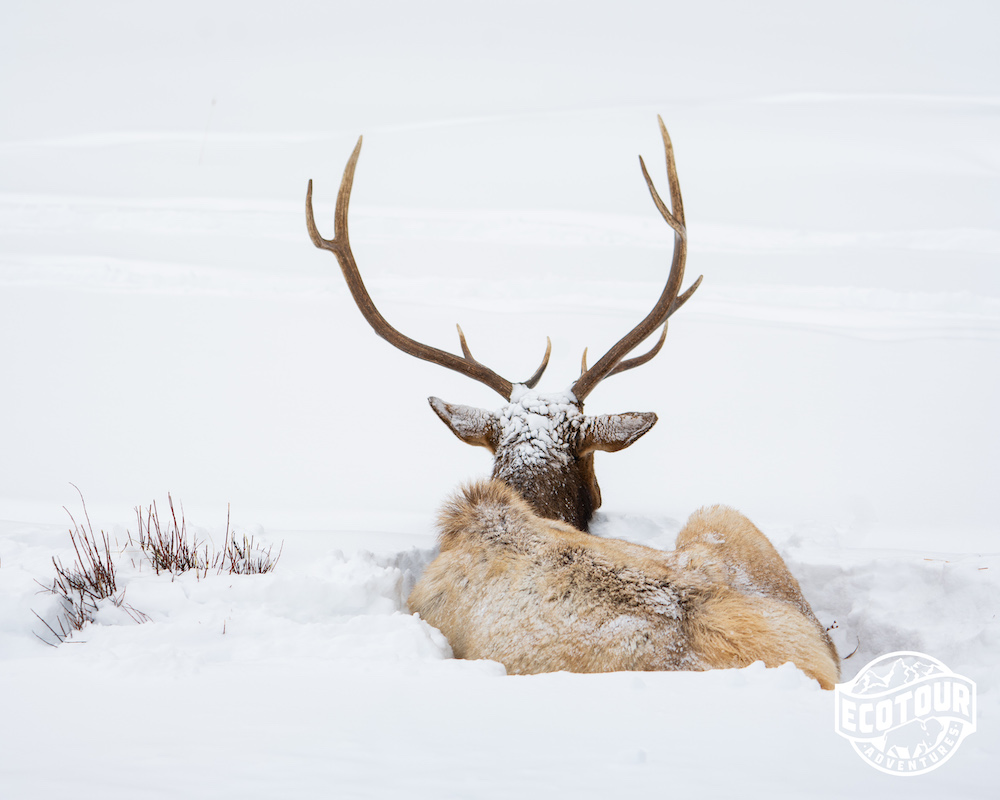
Bull elk often feed in the morning before resting and ruminating - using an extra stomach chamber and diverse microbes to help them digest dried grasses and other plants including fir needles!
At Geode Creek we spot dark shapes standing in the mixed spruce forest and willow marsh. This type of habitat provides the perfect combination of shelter (spruce trees) and forage (willows) for our largest deer species, the moose. Sure enough, a bedded cow and calf moose are revealed from behind the vegetation. Moose in Yellowstone are restricted to these limited habitats, largely in the northern part of the Park and we relish in the sighting before moving on.
In the Lamar Valley we pass the cabins and fenced corrals of the Lamar Buffalo Ranch, steam rising from nearby Rose Creek. In the late 1800’s the US Military established this site to assist with the recovery of bison in the park. By the Late 1800’s only around 23 wild bison remained in Yellowstone, a tiny fragment of the 40-60 million who once roamed the continent.
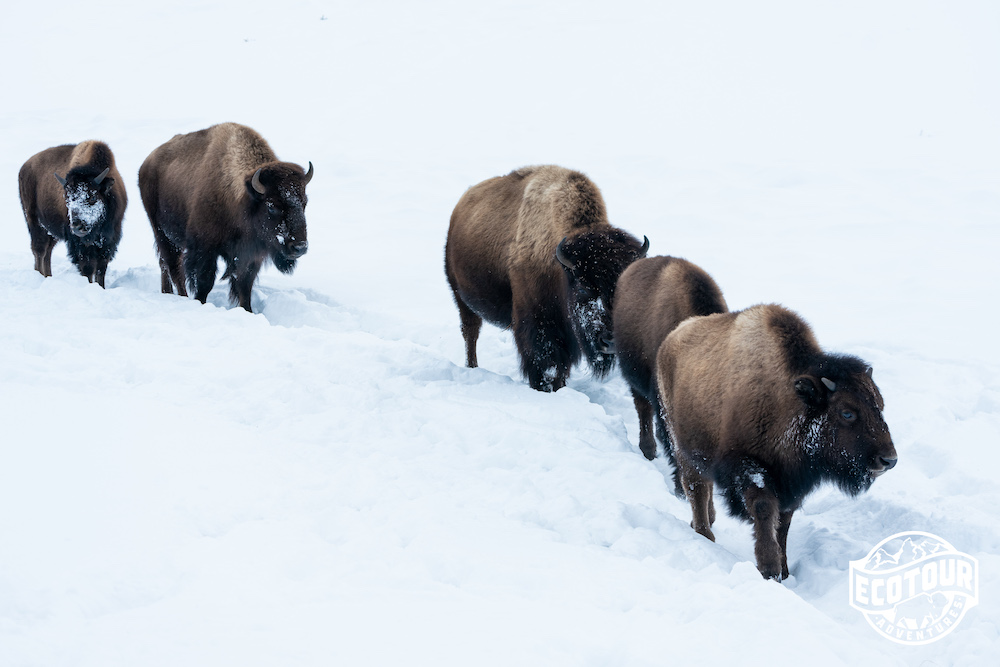
Yellowstone is home to the largest remaining wild herd of bison in the world today at over 4000 animals.
Our tour continues east. At the confluence of Soda Butte Creek and the Lamar River, American Dippers, our only aquatic songbirds, chas each other above the steaming waters, their beautiful calls echoing across the water. Above us, bighorn sheep graze along cliff bands, taking advantage of the snow free south facing slopes.
In winter, the end of the road through Yellowstone’s Northern Range is the small town of Cooke City, MT. The town is nestled amongst towering peaks and deep snow on the Beartooth Plateau closes the road east of here for several months of the year. We take a lunch break here before returning to the park for the remainder of the day.
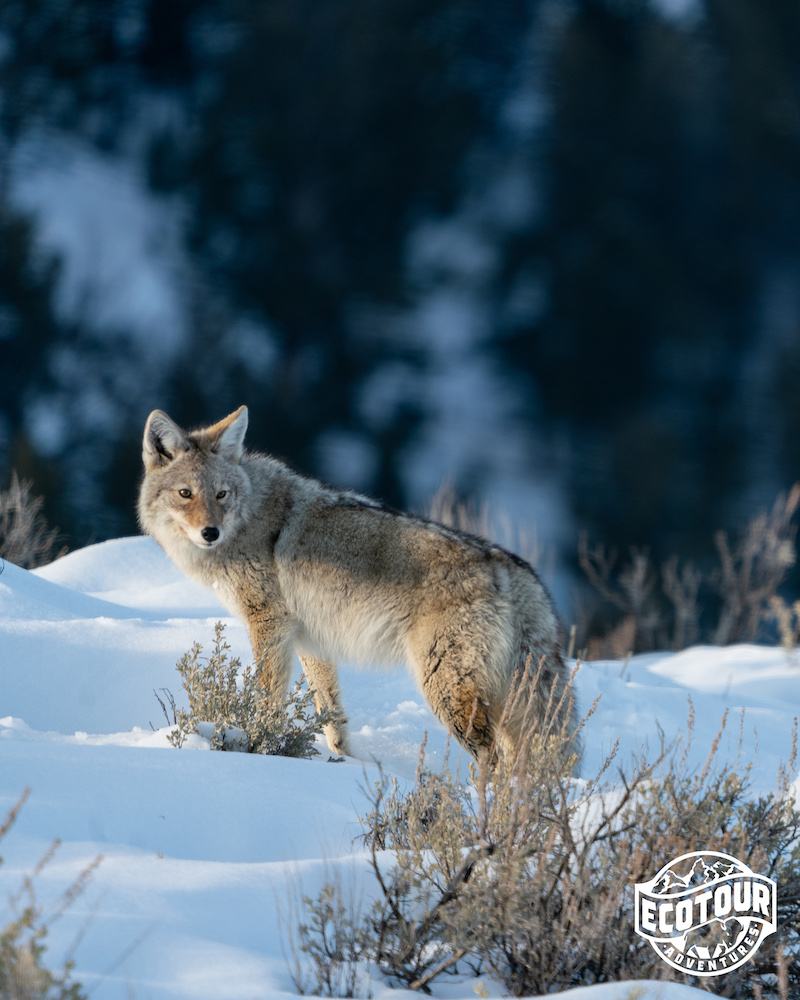
The ever adaptable coyote is found throughout the park in winter, including this one we observed in the Northern Range of Yellowstone.
Studying the Wild Wolves of Yellowstone
Returning to Gardiner, MT for the evening we are joined by a Yellowstone Wolf Biologist for a dinner time presentation on the latest research on this iconic species. Yellowstone is the perfect living laboratory for scientific research, and biologists have been carefully studying wolves since their successful reintroduction in 1995.
Learn more about what we've learned from 25 years of wolf research in Yellowstone here.
One of the most fascinating results of their research has been the disproportionate influence of older wolves over the age of 5 years on pack success. Using over a decade of data on wolf interactions, biologists found that when a pack had older, more experienced wolves they were more likely to win in territorial disputes with other packs. The old wolf was more valuable than even a big strong younger male in these conflicts. Scientists have found the same “wisdom of the elder” to be true for elephants and orcas, among other social mammal species.
A Private Snowcoach into the Winter Wonderland of Yellowstone
In winter, all of the roads in Yellowstone’s lower loop close to wheeled vehicles, but are open to guided snowmobile or snowcoach tours. With a good weather window in the forecast, we climb aboard our private snowcoach, its giant wheels keeping us atop the snow as we venture into the Park’s snowy interior.
At the Grand Canyon of the Yellowstone we take in views of the Upper and Lower Falls of the Yellowstone River. Mist from the lower falls has refrozen, forming an ice bridge across the canyon as the water cascades down behind it. Upriver, we spot an otter jump onto the ice. Mustelids, or weasels, have scent glands on their hind legs and we watched, amused as the otter does a little dance on the ice, leaving a message in scent for others to smell later.
We depart the snowcoach to take in an Old Faithful eruption and walk the snow covered boardwalks of Biscuit Basin and Fountain Paint Pots. Wind blows away the everpresent steam, revealing a kaleidoscope of color from the microbial life which still flourishes in these hot pools.
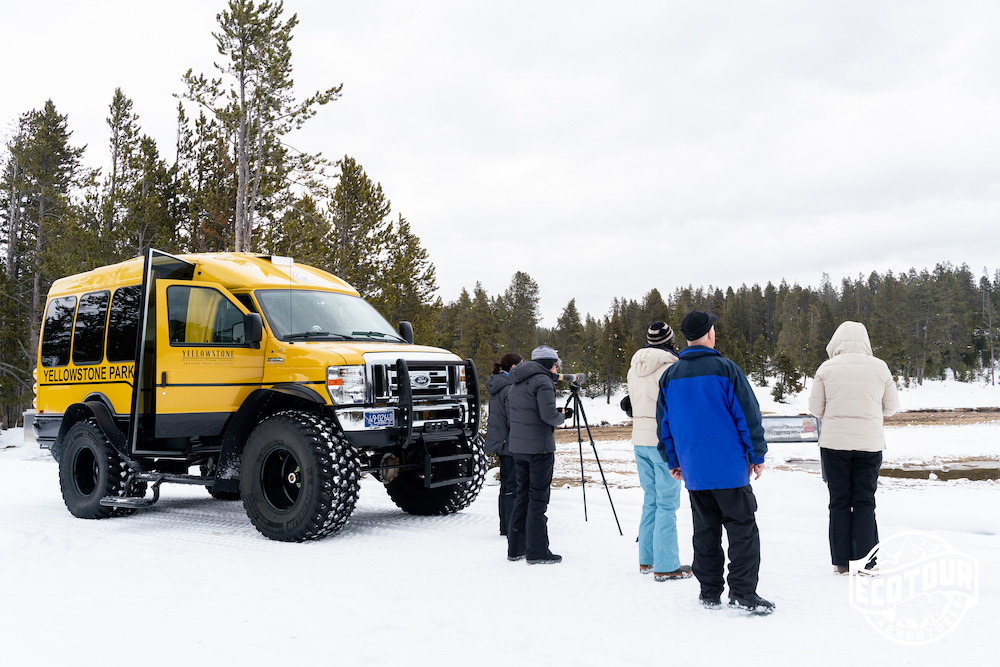
In a snow covered meadow near Norris Junction a flash of red catches my eye, and we stop to enjoy a red fox mousing in the snow. Winter is a great time to look for foxes who travel over the snow and hunt rodents hiding under the snow beneath them. Check out the video to watch a successful hunt.
The Junction Butte Pack tests Bison and Bull Elk
“WOLVES!”
With only around 100 wolves occupying the 2.2 million acre Yellowstone National Park sightings can be elusive. The diversity of wildlife spotted on our trip so far was satisfying yet we were still looking for the apex predator. On the final morning of our trip, they delivered. At Hellroaring Creek, the 16 member Junction Butte pack was spotted trotting single file through the snow. We excitedly watched as the pack tested a herd of bison, walking within a few feet of the giant beasts. Wolves are coursing predators, preferring to visibly approach prey, looking and smelling for weakness before choosing a target. This herd of healthy bison was having none of it and so the wolves moved on.
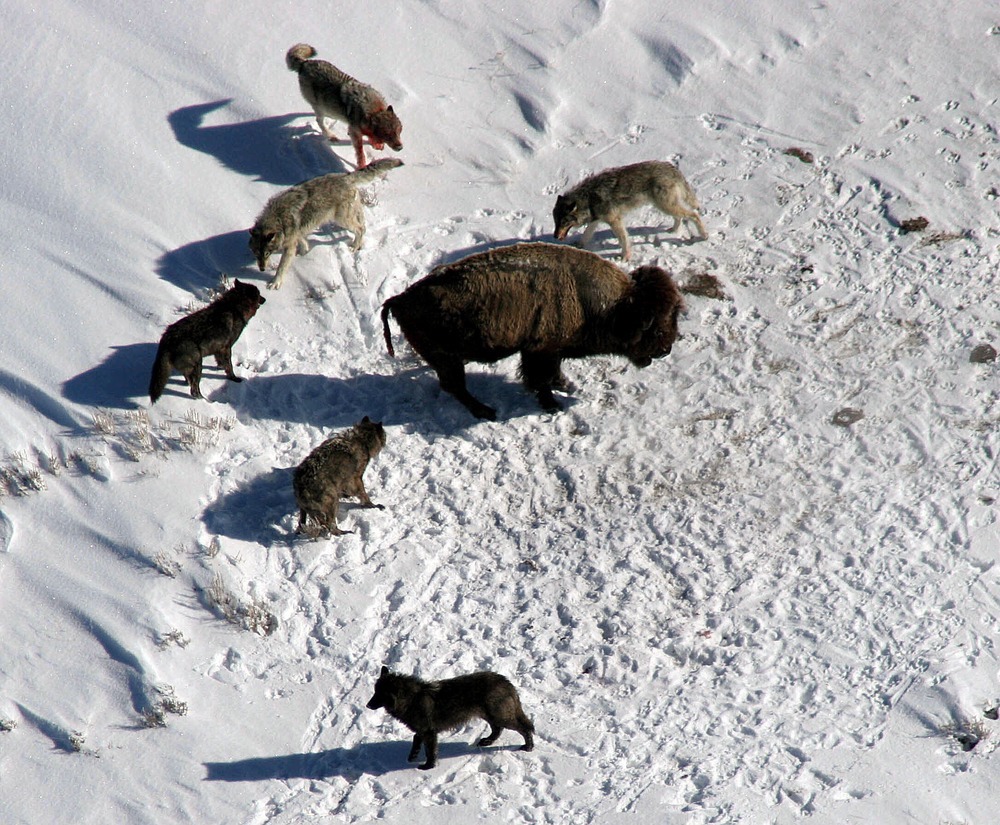
Bison make for a formidible prey animal but are most vulnerable in late winter. Photo: NPS/Doug Smith
Out of the trees two giant bull elk busted out into the open, visibly alarmed by the wolves presence. Yet the wisdom of the pack led them onward, these two bulls would be risky targets. In Yellowstone, the second leading cause of death to a wolf is injuries sustained from hunting and the wolves know it.
One by one the pack passed behind a ridge out of view, a spectacular viewing of true wildness. There are only a few places left in the lower 48 states where all of the large mammal species found here before Lewis and Clark remain, Yellowstone country is one of them.
Josh Metten is a senior Naturalist with Jackson Hole EcoTour Adventures. Learn more about our Winter Wolves and Wildlife of Yellowstone Multi Day Tour here.
“I had a wonderful time on Eco Tour Adventures’ Winter Wolves and Wildlife tour. The diversity of the tour, and the knowledge of the guide, was incredibly satisfying and I learned and enjoyed it so much.” - Joan, NY
“I was very impressed with the guide, his knowledge, and all of the attentiveness to detail and caring about each one of us! I learned so much and it was also such an enjoyable getaway for our family. I highly recommend you take a trip with Jackson Hole Ecotour Adventures.” - Sarah, NM






